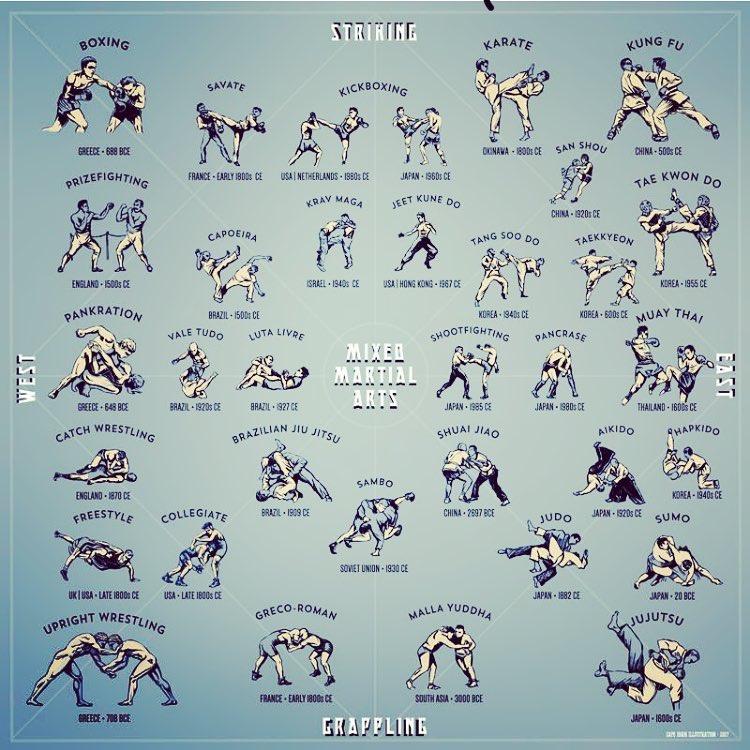Checking Out The Rich Heritage And Spiritual Dimensions Of Martial Arts: A Detailed Evaluation
Checking Out The Rich Heritage And Spiritual Dimensions Of Martial Arts: A Detailed Evaluation
Blog Article
Team Writer-Fyhn Patterson
Enter the old globe where martial arts were substantiated of necessity in varied areas. Societies crafted distinct fighting designs intertwined with historic contexts. Methods advanced over centuries with dedicated technique and cultural exchanges. Today, modern-day martial arts blend typical elements for maximum effectiveness. Philosophically, martial arts highlight self-control, self-improvement, and harmony. Respect, humbleness, and balance are fundamental concepts directing experts towards development and strength. Explore the midsts of this abundant history and approach to reveal the profound impacts forming this enduring self-control.
Beginnings of Martial Arts
Martial arts came from various areas around the globe, advancing as functional fight systems to resist risks. These old fighting designs were created out of requirement, with each society crafting strategies suited to their unique atmospheres and obstacles. From the grappling arts of Jujutsu in Japan to the striking techniques of Kung Fu in China, martial arts were deeply intertwined with the historical, social, and cultural textile of their corresponding cultures.
In Japan, the samurai course polished martial arts like Kenjutsu, the art of the sword, which later progressed right into the more popularized kind of Kendo. On the other hand, in Brazil, Capoeira emerged as a blend of dancing and combat, created by enslaved Africans as a way to withstand fascism. Each fighting style brings with it an abundant history and viewpoint, showing the worths and ideas of individuals that practiced them.
As you delve into the origins of martial arts, you discover a tapestry of human resourcefulness, resilience, and the stubborn spirit of warriors throughout time.
Development of Strategies
With centuries of practice and refinement, battle strategies within various martial arts have actually undergone an extensive advancement. From ancient styles like Kung Fu and Martial arts to much more modern disciplines such as Brazilian Jiu-Jitsu and Krav Maga, the development of strategies has actually been driven by a combination of social influences, sensible applications, and technological improvements.
One considerable facet of this advancement is the cross-pollination of methods in between various martial arts. As martial arts for over 60 , techniques from conventional Japanese Jiu-Jitsu were included right into the creation of Judo by Jigoro Kano in the late 19th century. This mixing of designs has actually resulted in the advancement of crossbreed martial arts like Mixed Martial Arts (MIXED MARTIAL ARTS), which incorporate elements of striking, grappling, and entry strategies.
Additionally, the advancement of techniques has actually been shaped by the increasing emphasis on performance and performance in battle. Specialists have actually continuously looked for to improve their strategies through extensive training, experimentation, and competitors, leading to the development of very specialized and reliable fighting styles. On the whole, the evolution of techniques in martial arts mirrors the vibrant nature of combat and the continuous mission for enhancement and advancement.
Philosophical Structures
Exploring the underlying thoughtful principles of martial arts offers insight right into their core worths and directing ideas. At the heart of numerous martial arts techniques is the idea of discipline itself. By training your mind and body to act as one cohesive device, you cultivate technique that extends past the dojo or health club right into everyday life. This discipline encompasses regard, humility, and self-constraint, shaping not simply your physical capabilities however also your personality.
An additional basic philosophical foundation in martial arts is the idea of continual self-improvement. The trip of understanding a fighting style is continuous, with professionals continuously making every effort to better themselves, both physically and mentally. related web-site on growth fosters durability, perseverance, and a growth frame of mind that can be related to all elements of life.
Additionally, martial arts highlight the value of consistency and equilibrium. Methods are designed to make use of an opponent's energy versus them, highlighting the concept of yielding and rerouting force rather than fulfilling it head-on. This philosophy includes social partnerships, promoting relaxed resolutions and good understanding. By welcoming these thoughtful foundations, martial artists not only improve their fight skills but likewise cultivate a way of life fixated individual development, respect, and harmony.
Conclusion
In conclusion, the background and viewpoint of martial arts use an abundant tapestry of practice, self-control, and self-improvement.
Consider example the story of Bruce Lee, that changed martial arts by mixing different styles and viewpoints to develop his own distinct type of Jeet Kune Do.
Via devotion and technology, martial artists continue to press limits and inspire others to reach their complete potential both in battle and in life.
